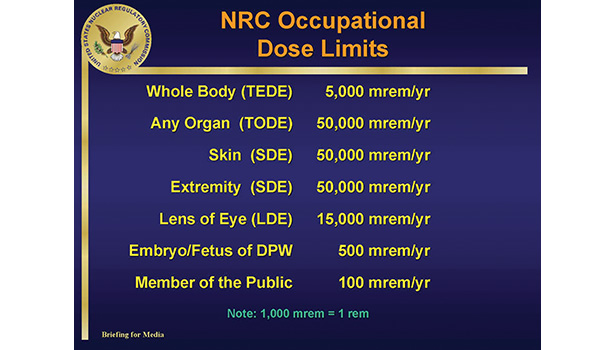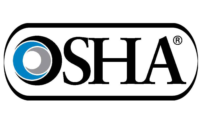Development of standards
According to the USDA Office of Homeland Security & Emergency Coordination (OHSEC), Radiation Safety Division (RSD) website, radiation safety standards and policies are set by a consensus among national and international scientific organizations, such as the Health Physics Society, the National Council on Radiation Protection (NCRP), and the International Commission on Radiological Protection (ICRP). The risks associated with low-level radiation exposure are conservatively calculated to be proportional to those observed with high-level exposure. These calculated risks are compared to other known occupational and environmental hazards, and standards are established to control and limit potential harmful radiation effects. In the U.S., the Nuclear Regulatory Commission sets regulatory dose limits for the public and occupationally exposed workers.1
Personal dosimeters
Radiation dosimetry is the calculation of the absorbed dose in tissue resulting from exposure to ionizing radiation. Dose is reported in units of gray (Gy) for mass, and dose equivalent is reported in units of sieverts (Sv) for biological tissue, where 1 Gy or 1 Sv is equal to 1 joule per kilogram. Traditional units are still prevalent as well, where dose is often reported in rads and dose equivalent in rems. By definition, 1 Gy = 100 rads and 1 Sv = 100 rems. Workers who may be exposed to radiation carry personal dosimeters. These dosimeters measure dose, based on a variety of measuring systems. The average background dose for a human being is about 350 milli-rems per year, resulting mostly from cosmic radiation and natural isotopes in the earth.1
Workers who should wear a personal dosimeter include healthcare or laboratory workers in non-emergency environments that may contain radiation (e.g., radiology, nuclear medicine, and radiation oncology department staff); workers in emergency environments that may contain radiation (e.g., first responders and first receivers); and workers in industrial environments where radiation is used (e.g., nuclear power plant workers or employees at radiation sterilizing facilities), according to the U.S. Department of Health & Human Services,
Flat badges are usually worn on the torso, at the collar or chest level, but can be worn on the belt, or forearm. Ring shaped badges can be worn on the finger when dose to the finger may exceed dose to the badge worn elsewhere on the body. Wear water-resistant personal dosimeters on the outer layer of personal protective equipment (PPE). You should be able to easily see and hear a dosimeter alarm while wearing PPE. Workers may wear a personal dosimeter underneath waterproof outerwear.2
Radiation exposure in the environment may not be uniform. Dose registered by a badge worn on the torso may not be the same as dose received elsewhere on the body. When working close to radiation sources, the hands/fingers may receive a higher dose than the torso, and should be monitored by a personal dosimeter on the finger. Also, real-time readings from personal dosimeters are not available from all devices. Emergency responders may require self-reading devices that provide dose information in real time.2
The OHSEC’s Radiation Safety Division provides the following list regarding the proper use of dosimeters, as well as the radiation dose limits outlined below.
Proper use of dosimeters
• Always wear your dosimeter when working with radioactive material. It should be worn on the shirt front, or on the waste at the pant or skirt belt or loop, with the front or name side of the dosimeter facing outward.
• Do not take your dosimeter home.
• Do not store or leave your dosimeter near radioactive material.
• Do not loan your dosimeter to a coworker or visitor.
• Do not wear your dosimeter during a medical procedure, where you might have an x-ray taken, for example, at the dentist’s office.
• Do not disassemble or otherwise tamper with your dosimeter.
• Do not continuing wearing the old dosimeter once you receive the new one.
Source: United States Nuclear Regulatory Commission
Radiation dose limits
Radiation workers: The yearly occupational dose limit for a radiation worker is:
• 5.0 rems for whole body
• 15.0 rems for lens of the eye
• 50.0 rems for skin or an extremity
Minor, in an occupational setting: The yearly dose limits for a minor working in a restricted area are 10 percent of the doses for an adult radiation worker. This is 0.5 rems (or 500 milli-rems) for a whole body dose.
Occupational dose for an embryo or fetus: The dose to an embryo or fetus, resulting from the mother’s occupational exposure, shall not exceed 0.5 rems (or 500 milli-rems) during the 9-month period of pregnancy. A woman who works in an area that is restricted for purposes of controlling radiation exposure may declare her pregnancy, in writing, to her supervisor, and request that the dose limits for the embryo or fetus apply to her for the duration of her pregnancy. When this occurs, the supervisor must contact the LRPO and RSD to obtain proper guidance and assistance in implementing this request, and maintain records of actions taken to meet the dose limit of 0.5 rems (or 500 mill-rems).
Internal radiation dose limits: The radiation dose from the inhalation or ingestion of radioactive materials must also be considered in the USDA Radiation Safety Program. The Nuclear Regulatory Commission places limits on the amount of radioactive materials that a radiation worker can take into their body over the course of a working year. This is called the Annual Limit on Intake (ALI). These values have been calculated for several radioisotopes and are listed in 10 CFR 20 Appendix B Tables, Table 1 ALI values for occupational dose …
If a radiation worker receives one ALI, the calculated radiation dose from that intake will be 5 rems. Currently, only the thyroid dose is actively monitored by the Radiation Safety Division. Using standard tables, the whole body effective dose equivalent can be estimated. Regulations require that the total external and internal radiation dose to a worker not exceed 5 rems in one year.
Dose limits for members of the public: NRC or agreement state licensees shall conduct operations so that the dose to individual members of the public from the licensed operation does not exceed 0.1 rem (or 100 milli-rems) in a year.
References
1 USDA Office of Homeland Security & Emergency Coordination, Radiation Safety Division (RSD), “Dosimetry”,
www.dm.usda.gov/ohsec/rsd/dosimetry.htm
2 U.S. Department of Health & Human Services, Radiation Emergency Medical Management, “Radiation Detection Devices”, www.remm.nlm.gov/civilian.htm


